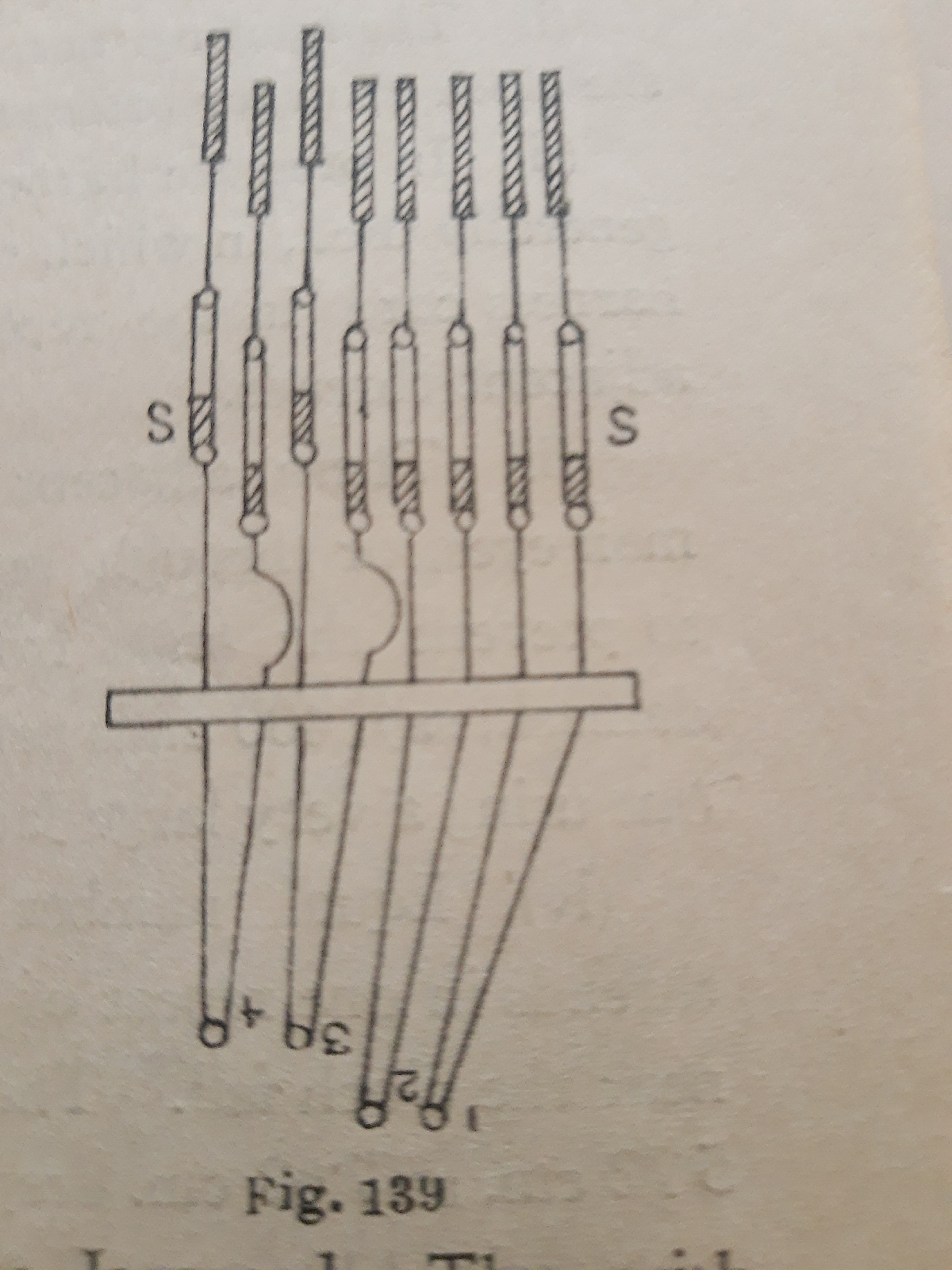Increase in Figuring Capacity of Jacquards:-
Increase in Figuring Capacity of Jacquards:-
There are two methods of increasing the figuring capacity of a Jacquard:-(1) Without any modification of the Jacquard mechanism and harness building: and
(2) With modification of hooks needles and harness building of the Jacquard machine.
1. According to the former method , the figuring capacity may be increased by introducing any of the following ways:-
(a) By introducing center or V-draft in harness building (fig.133)
(b) By increasing two or more jacquard and
(c) By using a cross border Jacquard,( Fig. 127)
2. According to the latter method , the figuring capacity may b increased in the following ways:-
(a) Inverted Hook Jacquard (fig.138)
Fig. 138 inverted hook jacquard
(b) Split hook Jacquard (fig.139)
(c) Pressure harness (fig.140) :and
(d) Working comberboard.
Split or Scale Harness:-
The split harness also known as 'shaft monture’, 'scale or Bannister harness' , is an ingenious method of increasing the size of s pattern which can woven on s given Jacquard. Nonreversible damask or other types of rich silk fabrics in weaving a wide repeat with comparatively much lesser number of picks than ends , are woven by this method to save the use of s large Jacquard. The split harness is only adopted for very fine reed in cotton weaving, but it is much use in silk manufacture , where even 300 or 400 ends per inch or 2.54cm. sra introduced.A double split harness is illustrated in fig.139.
A 'double-scale' split harness consist of two adjacent lingoes being connected to each hook in the Jacquard. This with s 400s Jacquard there are 800 mail eyes in a pattern. In the figure, a few lingoes are shown tied in the manner of a double scale harness . The connections to four hooks are shown .
Below the comber board a loop is made in the harness thread. Shaft or strips of wood or metal SS are inserted through the loops in each row in the harness . These shaft are worked by the spare hooks in the Jacquard. In the places where the ends are left down by the Jacquard, the shafts will weave the ends singly, being lifted to a given pattern.
In the figure , every alternate shaft is lifted to a plain ground. Hooks 1 and 2 are lifted by the Jacquard, hook 3 and 4 are left down. The ends , when lifted, cannot be woven separately and the binding of the figure is plain.
PRESSURE HARNESS:-
When a Jacquard is used in combination with healds to move the same warp threads , it is known as 'pressure harness' .
(i) The figuring harness is placed farther from the fell of the cloth than for ordinary work.
(ii) In pressure harness an ordinary single lift Jacquard is generally used, in which one needle controls one hook and one harness cord in the repeat. But one hook governs 2 to 12 adjacent threads.
(iii) These adjacent threads are drawn through separate mail eyes, or through separate eyes in a 'deck mail' in order to prevent the ends from twisting. Thus a very large silk damask ,say 400 ends per inch or 2.54cm. can be woven without using a very large Jacquard.
(iv) Equal number of heald shafts , as the number of threads in one repeat of the binding weave, are suspended very near the cloth fell. These shafts have long eye 2 1/4" to 3" or ,5.72 cm. to 7.62cm. deep to permit of the shed being opened.
At fig. 140, two Jacquard lingoes are shown behind the heald-shaft. Lingoes A are lifted and lingoes B are left down. There may be a few or many ends in each mail eye, say five . Now ends are drawn through mail-eyes in fives, and singly through heald-shafts in front . The heald-shafts may be operated by tappets, dobbies or Jacquards. Here they are operated by a jacquard.
A small pulley is placed between the hooks and the shafts. Each shaft is connected to two hooks , a cord from one hook is passing round the pulley to the other hooks . When both hooks are lifted the shaft will be lifted to the top , like the shaft no.1. When only one hook of the pair is lifted , the shaft will be taken half-way,
like the shaft nos. 2, 4 and 5 . When Both hooks are left down, the shaft is left at the bottom, like the shaft no. 3 in the figure. Thus with one shaft at the top , one at the bottom and the other three lifted half-way, a figure repeating on 2000 ends can be woven on a 400s Jacquard, every end being woven singly in both the ground and the figure. Very small shuttle and sheds are employed and this is this harness is better adopted for very fine warps.
The disadvantage is that when both healds and mail eyes are operated by the same griffe, there us an unequal strain upon the harness mails as they are placed back . However , the pressure harness is largely used on handlooms for producing larger figures than the size of a jacquard in combination with healds.
Ref:-Weaving Mechanism Book Vol. 1 by Prof. N. N. Banerjee.









Comments
Post a Comment